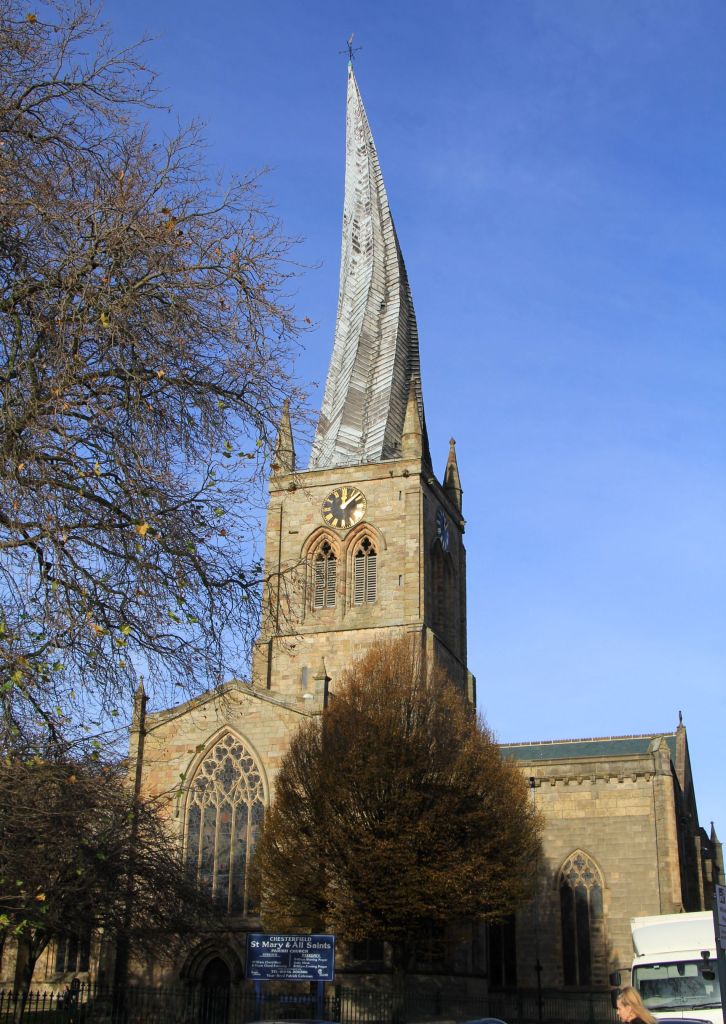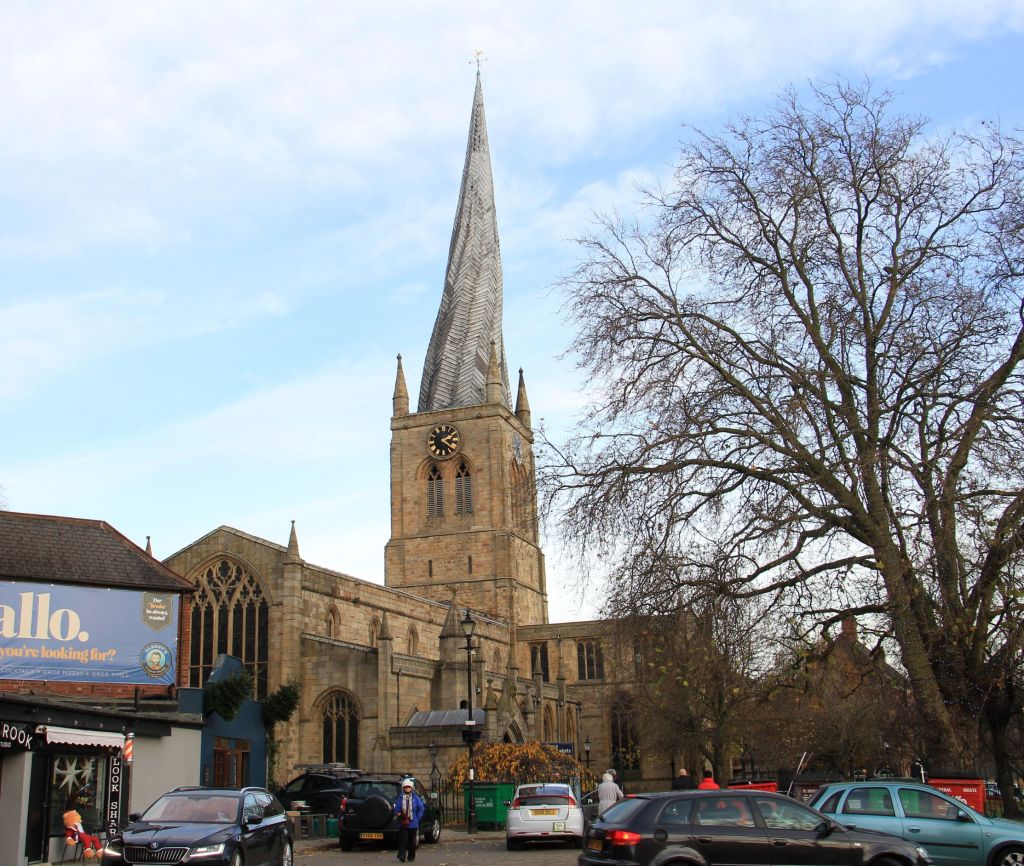Andy Warhol is said to have observed that in the future everyone will be famous for 15 minutes. By extension it might be argued that everywhere will be famous too, that each and every place under the sun will become well-known for something, albeit in most cases something rather insignificant. Chesterfield, for example, is famous for the crooked spire that graces its medieval church, but for little else.

Chesterfield, for the uninitiated, is a town in the north of my home county of Derbyshire. Home to around 100,000 people, for the most part it’s a pleasant though unremarkable place. The coal industry that once dominated the landscape and economy of this part of Derbyshire is all gone now, and today Chesterfield’s role is primarily as a service centre for the surrounding area.
Bizarrely, just as I was about to start writing this post, a news report popped up in my inbox declaring that, according to a recent survey, Chesterfield is the happiest place to live in the whole of the English East Midlands. Really? I worked there for a couple of years in the late 1980s and don’t recall it being unusually joyful. But maybe the outbreak of local happiness coincided with my departure? Sounds plausible!
Reading the newspaper report more closely, I see that even some of the local residents query the accuracy of this accolade. Objectively, I suspect most unbiased observers would regard Chesterfield as memorably unmemorable, were it not for the iconic architectural imperfection otherwise known as the parish church of St Mary and All Saints.
Completed around the year 1360, St Mary’s and All Saints is Derbyshire’s largest church. It’s famed for its unusual crooked spire, which leans 9 feet 5 inches (nearly 3 metres) from true. To be clear, this is not an eccentrically flamboyant design statement…the spire is meant to point straight up, like every other church spire in the known universe.

So what went wrong? The traditional explanation is that it was built with green, unseasoned timbers, which warped over time. But that can’t be it. Builders in the Middle Ages were accustomed to using used green timber, and would have made allowances to cope with it.
A more convincing explanation is that the spire’s 32 tonnes of lead tiles were simply too heavy. According to this theory the sheer weight of the tiles, combined with the failure to use cross-bracing, caused the spire to twist and lean alarmingly.
The omission of cross-bracing has been blamed on the Black Death, a plague that swept through the country between 1348 and 1350. If the experienced craftsmen working on the new Chesterfield church were killed by the disease, the spire may have been finished by unskilled builders to whom the concept of cross-bracing was totally unknown.
Accurate though this explanation may be, it’s disappointingly boring. Unsurprisingly, local folklore offers some more entertaining possibilities. One of these tells that the Devil was resting on the spire, where he was able to keep his balance only by wrapping his tail around it. However the smell of holy incense from inside the church offended him so much that he sneezed violently, jerking his tail in the process and causing the spire to twist.
A second explanation also blames the Devil. Old Nick was resting up on the church spire, his tail tightly wrapped around it while planning mischief and mayhem. In fear for the souls of his fellow townsfolk, one brave man rushed to the church, determined to warn everyone by ringing the church bells. The din was cacophonous. Taken totally by surprise, a shocked Devil lost his balance and toppled from the spire, twisting it as he plunged to the ground.

A third local legend once again points the finger of suspicion at the Devil According to this story, Satan was resting on the spire, tail wrapped round it in the now familiar manner. Looking below, he noticed a wedding about to take place in the church. On closer inspection he realised that the bride was a virgin, an occurrence so surprising in Chesterfield that he fainted from shock. As the unconscious Devil hurtled towards the ground his tail, still wrapped around the spire, twisted it into its current shape.
The fourth theory lets the Devil off the hook, and instead puts the blame squarely on the healthy sexual appetite of Chesterfield residents. According to this version, a virgin got married in St Mary’s, and the church itself was so surprised that its spire turned around to get a better look at such a rare specimen. The legend continues that if another virgin ever marries in the church, the spire will return to its original form again. Don’t hold your breath, folks!
Further explanations for the origin of Chesterfield’s crooked spire are available if you care to look, most of them involving the Devil or unexpected virgins. A definitive, agreed version, doesn’t seem likely to emerge any time soon. However, one thing is beyond dispute: the locals have taken this quirky architectural blunder to their hearts.

For example the local professional soccer team, Chesterfield Town FC, are known to fans as the Spireites, while over the years various local businesses have referred to the crooked spire in their branding and promotions. And who can blame them? Chesterfield’s crooked spire is a spectacular sight, and ensures that an otherwise rather unexceptional town enjoys its 15 minutes of fame. Andy Warhol would be impressed.
Amazing, I’ve never seen that before, quite the architectural oddity! Interesting that the Devil gets the publicity when my granddaughter took a look and said it was a lost Unicorn horn 🙂
LikeLiked by 1 person
I can see just what she means. Chesterfield is a grounded, earthy place, and I suspect a unicorn is just too whimsical to have entered the consciousness of its citizens. The Devil, however … 🙂
LikeLiked by 1 person
Ah, yes, The Devil is far more audacious.
LikeLiked by 1 person
Unicorn horn is a much nicer explanation, but it’s hard to beat the devil. 😉
LikeLiked by 2 people
Somewhere, in a parallel universe, Chesterfield has probably branded itself as “the unicorn town”, unlocking up all sorts of interesting commercial and creative opportunities. 🙂
LikeLiked by 2 people
Many years ago I went to Chatsworth House by rail – and saw the church spire. Such a delightful unintentional architectural feature. Makes one smile!
LikeLiked by 1 person
One seen, never forgotten. Such a quirky architectural imperfection would never have been tolerated at Chatsworth House!
LikeLiked by 2 people
Greetings. I like the crooked spire. Reminds me of a candle flame being blown a bit by a breeze. Maybe the builders intentionally made it crooked!
LikeLiked by 1 person
That’s an interesting take on it, I’ve not heard it described in those terms before. A crooked spire is definitely far more interesting that one that stands up straight!
LikeLiked by 2 people
I have to agree with our fellow bloggers who are enamored of the crooked spire. It gives the church a certain distinctive look. I find it remarkable that people came up with the most abstruse explanations rather than accept a simple mechanical one. That’s not so different from some of the strange theories floating around today with regard to any number of phenomena, be they natural or man-made.
Just an aside–your “Old Nick” reference made me stop for a second. You are, of course, aware, that in the US, “Old St. Nick” is another name for Santa Claus, so I expected some story related to Christmas, but was set straight soon thereafter.
You certainly succeeded in proving Andy Warhol right. 🙂
LikeLiked by 1 person
The Devil has always been the scapegoat for follies of mankind’s own making! (Do you know the comic strip character Garfield the cat? I remember one story in which he is pictured in the kitchen, stealing Jim’s chicken soup. Jim catches him in the act. Garfield’s guilt is obvious, the evidence is plain for all to see, but the stripy orange cat still protests his innocence, saying “the Devil made me do it.” I think those Chesterfield church builders had a similar, desperate motivation.)
The appellation “Old Nick” for the Devil seems to go back many hundreds of years. It isn’t used very much these days, so I thought I’d revive it. I’d certainly never blame Santa for damaging a church spire…after all, he’s one of the good guys! 🙂
LikeLiked by 2 people
I am familiar with Garfield, but I don’t read the comic regularly and missed that particular episode. Taking the blame for something we did wrong isn’t difficult only for humans, it seems, but is a universal trait of living, thinking beings.
Since Santa is known to land on roofs, blaming (or crediting) him for the crooked spire isn’t that far fetched, though! 🙂
LikeLiked by 2 people